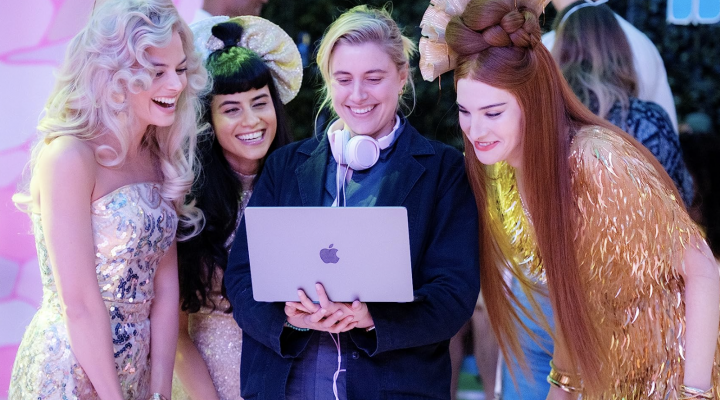The Academy Awards are not the final word in film, but like any institution they reflect the power dynamics of American society, including those in the church. That’s why the Academy denying Greta Gerwig a nomination for best director for her blockbuster and barrier-breaking film Barbie is such a big deal.
Gerwig’s fingerprints are all over the Barbie movie. She is an auteur with a point of view who was heavily involved in the many facets of the film’s production. Production designer Sarah Greenwood told The New York Times, “It was one of the most difficult philosophical, intellectual, cerebral pieces of work we’ve ever done.”
Gerwig’s Barbie engages issues of identity, womanhood, consumerism, patriarchy and the meaning of life through the pink plastic lens of a toy doll. This Oscar snub is just another example where a woman must once again “always stand out and always be grateful but never forget that the system is rigged,” to quote America Ferrera’s character, Gloria, in the movie.

Barbie has had 250 careers, illustrated in this photo by the manufacturer.
‘The system is rigged’
The system is rigged. The Academy of Motion Picture Arts and Sciences has 9,500 voting members organized into 17 branches who choose the nominees for their categories. This means only members of the Directors’ Branch nominate candidates for Best Director. (All members of the AMPAS may vote for the Best Picture nominees.) To be a member of the Directors’ Branch, a director must have made two films that are up to the Academy’s standards or a single film if it was nominated for an Oscar in the best directing, best picture, or best foreign language film categories.
“Very few members of the Directors’ Branch are women because women receive far fewer opportunities to direct.”
Yet very few members of the Directors’ Branch are women because women receive far fewer opportunities to direct. According to the Annenberg Institute, from 2007 to 2018, women directed just 4% of the top 1,200 films, and of those few female directors, only 17.4% were given the chance to direct again.
By contrast, in this same period 45.7% of men who made a top film went on to direct a second film. In her directing lifetime, which is decades shorter than her male counterparts due to societal and structural hurdles, a woman may direct one to four films, while a man may direct one to 17 films. Because of this imbalance, only a fourth of those voting for the Best Director nominees are women.
So, in such a rigged system, how does a woman hope to win an Oscar for best director? Direct like a man. Direct the kinds of movies men like: wars and Westerns.
Katherine Bigelow won best director for the The Hurt Locker, a thriller about the Iraq War, and Jane Campion won for The Power of the Dog, a Western about the tangled lives of three men. In Barbie, however, Gerwig pokes fun at these “manly” genres.
Hollywood loves Hollywood
When Barbie Land becomes a Ken-dom, all the Kens don cowboy hats and the Barbie Dreamhouse is redecorated in a kitschy horse motif complete with saloon door. The film’s “war sequence,” the climactic “Battle of the Kens,” dissolves into a dance off reminiscent of West Side Story.
Throughout the Barbie movie, Gerwig is continually referencing other films like Grease, The Wizard of Oz, 2001: A Space Odyssey and the French film Umbrellas of Cherbourg. She conducted “movie church” screenings every Sunday for the cast and crew to better understand her influences. Normally, the Academy directors adore these insider allusions. They awarded Damian Chezelle best director for La La Land, a film full of Hollywood references, and nominated Martin Scorsese for Hugo, an ode to early silent movies. Perhaps Gerwig wasn’t reverent enough in her treatment of the cinematic canon. Maybe one joke about The Godfather is one too many for her esteemed colleagues.
Within cinema history, there is a genre of film that does center the female protagonist known simply as the “Woman’s Film.” In such movies, the female protagonist escapes her everyday life to experience romantic love, a sexual awakening or life outside her prescribed role. At the end of the narrative, she must choose either convention or liberation. These melodramas sustained the film industry during World War II and featured actresses like Bette Davis and Olivia de Havilland. The 1980s and 1990s saw a resurgence in the genre with such movies as Coal Miner’s Daughter and Thelma and Louise.

Margot Robbie as Barbie
‘Lesser’ films
Because of the anti-female biases inherent in the film industry, movies by women about women are often considered “lesser.” Less serious, less important and their directors less deserving of recognition.
While studies show it’s a movie’s budget that determines its box office success, not whether it is directed by a man or a woman, studios are more likely to entrust a man with a big budget film.
“Over more than a decade and a half, the percentage of women in top directing jobs has not even grown by 10 percentage points,” said Stacy L. Smith of USC Annenberg. “These figures are not merely data points on a chart. They represent real, talented women working to have sustainable careers in an industry that will not hire them into jobs they are qualified to hold solely because of their identity.”
“When women direct movies, they hire more women for other positions.”
Lack of representation at the top has a ripple effect throughout the industry. When women direct movies, they hire more women for other positions. Women comprised 61% of writers, 35% of editors, 10% of cinematographers and 26% of composers for films that had at a female director. In movies directed by men, only 9% of writers were women, 18% of editors, 7% of cinematographers and 11% of composers.
When deserving women aren’t nominated for best director because of a lack of representation inside the Academy, it affects women outside the film industry as well. Their perspectives and interests do not have a voice. Some critics saw Barbie as little more than a frivolous comedy; but defining it as such ignores the millions of women who identified with Gloria’s and Barbie’s struggle against the patriarchy and its rigged system.
Greta Gerwig’s films elevate the stories of women. She has a history of making films about the complexities of womanhood centered around female protagonists such as Lady Bird and Little Women. Both were nominated for best picture. With each successive film, she’s garnered more acclaim and a bigger budget.

Barbie in Barbieland
The ‘Woman’s Film’
Conventional Hollywood wisdom says the “Woman’s Film” doesn’t sell, but with Barbie Gerwig proved the female viewer can be an economic powerhouse at the theater. Barbie brought moviegoers back into the theater after COVID and became the highest-grossing box office film of 2023, earning $1.44 billion worldwide. The Golden Globes awarded it a special award for cinematic and box office achievement.
In the face of Barbie’s far-ranging success and cultural impact, denying Gerwig her well-earned nomination for best director lays bare the systemic sexism in the film industry. It also cuts the Barbie movie loose from Gerwig’s authority. As solely a best picture nominee, those threatened by the film’s anti-patriarchy message no longer must acknowledge or contend with Gerwig’s artistic and political perspective.
The same was true when the Directors’ Branch snubbed Ava DuVernay for her Black Lives Matter activism around Selma. This ensures the takeaway from Barbie is the studios need to make more movies about toys, rather than the industry should let more women direct. The male powerbrokers in Hollywood don’t mind the money female filmmakers earn them; but they certainly aren’t going to jeopardize their own power to get it.
Women who direct foreign films or smaller independent films are more likely to receive a best director nomination. Gerwig herself received one for Lady Bird. This year, French director Justine Triet is nominated for best director for her courtroom drama Anatomy of a Fall, which was awarded the top prize at Cannes. In 2021, Chloe Zhao won best director for her intimate film Nomadland. Perhaps male AMPAS voters don’t see such movies and their female directors as threats so long as they don’t disturb or critique the Hollywood establishment.
Was the film that good?
Critics responding to the outrage over Gerwig’s Oscar snub contend perhaps Barbie wasn’t that good after all. Such responses are defensive and patronizing. The quality of the movie isn’t at issue. The full Academy decided Barbie is worthy of a best picture nomination, and the members of the Writers’ Branch nominated Gerwig for best adapted screenplay. The issue at hand is the nomination for best director and the authority that accompanies this honor. Did Gerwig bring artistry and technical mastery to her work? Did she bring out the best in her actors, two of whom are nominated for their supporting roles? Did she advance the medium of film?
Yes. She did all these things, “backward and in high heels,” as the saying goes. But the systemic sexism in the film industry, particularly in directing, is a barrier to acknowledging Gerwig’s achievements.
“The industry often takes women’s work for granted, and even the women behind the highest-grossing film of the year or most critically beloved are not exempt,” said Kirsten Schaffer, chief executive officer of Women in Film, a nonprofit that advocates for women in the movie industry.
As also seen in the church
None of this comes as a surprise to women at work in another American institution, the church. Women in ministry are subject to many of the same sexist barriers as women in movies.
“Only 12.9% of American Protestant churches are headed by female pastors, roughly the same percentage of female directors heading top grossing films.”
Only 12.9% of American Protestant churches are headed by female pastors, roughly the same percentage of female directors heading top grossing films. While the Southern Baptist Convention and other denominations have barred the doors to female pastors, moderate Baptist churches haven’t exactly flung those doors wide open. According to a 2022 Baptist Women in Ministry report, in Cooperative Baptist Fellowship churches the number of female pastors is only 7%, although Katie Lauve-Moon in her book Preacher Woman: A Critical Look at Sexism Without Sexists suggests it is closer to 5%. Even an egalitarian theology is no match for entrenched attitudes and systemic barriers.
While enrollment in Mainline seminaries is evenly split between male and female students, fewer female graduates are hired for leadership positions in the church. Search committees’ unconscious gender biases advantage male pastoral candidates. Historically, since most pastors have been men, masculine leadership styles tend to be the benchmarks for measuring success.
Just as studios are more likely to hire men to direct big-budget movies, big-budget churches are primarily led by men. Churches led by women are more likely to be smaller and in financial trouble. Transitioning from a small church to a larger, more influential church is the greatest barrier faced by women in ministry according to the Benchmarking Women’s Leadership study.
These barriers limit a female pastor’s income and her impact. Serving a small church, she is less likely to be invited to speak at denominational events and less able to participate in peer networks.
“Male leaders receive funding, opportunities and recognition based on their potential — while women pastors need a track record to even be considered for any of those,” said Jill Richardson of Real Hope Community Church in Chicago.
Likewise, Patty Jenkins ,who directed Charlize Theron to a best actress Oscar for Monster, didn’t direct again until 2017. She spent that decade trying to convince studio heads to greenlight Wonder Woman, which earned $822 million worldwide and made Jenkins the highest grossing solo female director until Gerwig. At the same time, studios gave male directors Colin Treverrow, Marc Webb and Gareth Edwards massive franchises (Jurassic World, Spider-Man and Godzilla respectively) after directing only one independent film each.

The ‘Baptist Barbie’
In Church Land, it’s not only ministry by women that is belittled, but also ministry to women. Just like the “Woman’s Film,” women’s ministry in churches is often viewed as less important, even though women outnumber men in attendance and participation.
There is no greater example of this dynamic than Beth Moore’s “Baptist Barbie” experience.
“Male leadership in the SBC welcomed the work Moore did spreading conservative evangelicalism as long as she stayed within the sphere of women’s ministry and didn’t threaten their authority.”
Beloved by women across denominations, Moore was the first woman to publish a Bible study with Lifeway Christian Resources. Her books sustained the company, earning Lifeway $30 million a year in revenue when Moore was at the height of her popularity. Not only were women gathering in churches to study Moore’s teachings, 22 million of them worldwide attended or participated remotely in her Living Proof Live events.
Male leadership in the SBC welcomed the work Moore did spreading conservative evangelicalism as long as she stayed within the sphere of women’s ministry and didn’t threaten their authority. In 2016, Moore began questioning conservatives’ unwavering support for Donald Trump after the release of the “Access Hollywood” recording. She spoke out on Twitter and, in solidarity with the #MeToo movement, Moore published an open letter rebuking the patriarchal systems she had encountered in ministry.
The blowback from the male SBC establishment was swift and extreme, questioning her faith as well as her abilities. They told her to keep quiet and stay in her lane. But she refused. Moore left Lifeway and the SBC for good in 2021, and she hasn’t looked back.
At the end of Barbie, Barbie, like all “Woman’s Film” protagonists, is faced with a choice: remain in Barbie Land, the ideal image of a woman, or, having seen the real world, become a real woman and be the one doing “the imagining.” She chooses humanity and the ability to create her own path despite the patriarchy.
Women working in movies and in ministry must do the same. The system is rigged. Let’s create a better one.
Kristen Thomason is a freelance writer with a background in media studies and production. She has worked with national and international religious organizations and for public television. Currently based in Scotland, she has organized worship arts at churches in Metro D.C. and Toronto. In addition to writing for Baptist News Global, Kristen blogs on matters of faith and social justice at viaexmachina.com.
Related articles:
It’s time for Pastor Barbie | Opinion by Patrick Wilson
Why the patriarchy is hyperventilating over Barbie | Analysis by Rick Pidcock
Can Barbie help us create justice? | Opinion by Val Fisk


